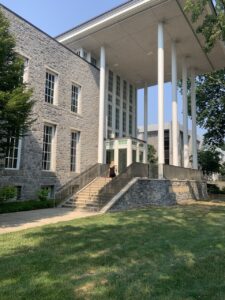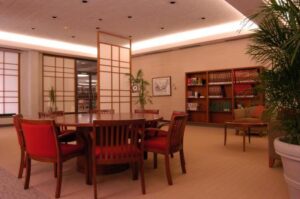
Waidner-Spahr Library (Charlotte Goodman)
My housing record may indicate that I lived in Adams and Witwer Halls, but I would argue that the library has been my real place of residence at Dickinson, except for sleeping and bathing. I have really left my mark on the place, too- not just because I am there every waking minute of the day when I’m not in class, but also because I have spilled almost every cup of coffee I’ve brought in there. The most frequent victim of my clumsiness and also my favorite spot, is on the ground floor in the quiet section tucked in the very back left corner behind all of the book aisles. I can sit there for hours doing work. It is a pretty convenient spot, too, because I find myself learning and doing a lot of projects on genocides, especially the Rwandan genocide, and a lot of those books are found in the aisle right behind me. I take occasional snack breaks which were always made especially easy because the Biblio café is located on the same floor. These breaks were problematic for me because they always turned into hour long conversations with Carrie, my favorite barista, about school and her kids. Clearly, I’m easily distracted and obviously more productive when I’m not near other people, so that is why I am always sitting in the corner of the quiet section. But, there are other great places in the library to do work or hangout. I remember for my International Relations class, some of the students and I would have regular study sessions in the upstairs “fish bowl”- the protruding room with all of the windows. There are also individual study rooms located on that floor as well as in the basement that are always being used- during the year in order to secure one, students normally have to rent them out beforehand. The East Asian Studies room is also popular among students because it was designed according to East Asian culture and it has its own library of Chinese and Japanese literature.

East Asian Studies room (Dickinson Archives)
I love the library for academic and social purposes, but sometimes I forget to take a step back and enjoy how beautiful and historically rich it is. By this, I don’t just mean it has a lot of books, I’m referring more specifically to things like the college archives and its special collections. Located in the basement, the archives contain primary documents related to Carlisle’s past such as collections on the Carlisle Indian School and the Civil War. In my first year seminar, Education (In)Justice, I was able to look at letters written by Richard Henry Pratt, founder of the Carlisle Indian School, and some of the Native American students. In addition to the archives, even a walk around the building can reveal relevant historical information, such as paintings of people who were important to the college, like former President James Buchanan. I highly recommend checking it out!
Leave a Reply